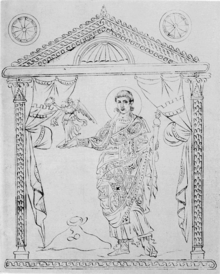|
Asterius of AmaseaSaint Asterius of Amasea (Greek: Ἀστέριος Ἀμασείας, c. 350 – c. 410 AD)[1] was made Bishop of Amasea between 380 and 390 AD, after having been a lawyer.[1][2] He was born in Cappadocia and probably died in Amasea in modern Turkey, then in Pontus. Significant portions of his lively sermons survive, which are especially interesting from the point of view of art history, and social life in his day. Asterius, Bishop of Amasea is not to be confused with the Arian polemicist Asterius the Sophist.[2] His feast day is October 30.[3] Life and workAsterius of Amasea was the younger contemporary of Amphilochius of Iconium and the three great Cappadocian Fathers.[2] Little is known about his life, except that he was educated by a Scythian slave. Like Amphilochius, he had been a lawyer before becoming bishop between 380 and 390 AD, and he brought the skills of the professional rhetorician to his sermons.[4] Sixteen homilies and panegyrics on the martyrs still exist, showing familiarity with the classics, and containing an unusual concentration of details of everyday life in his time. One of them, Oration 4: Adversus Kalendarum Festum attacks the pagan customs and abuses of the New Years feast, denying everything that Libanius had said supporting it – see Lord of Misrule for extensive quotations. That sermon was preached on January 1, 400 AD, which provides the main evidence, with a reference in another to his great age, to the dating of his career.[4] Artistic references In Oration 11, On the martyrdom of St. Euphemia, Asterius describes a painting of the martyrdom and compares it to pictures made by the famous pre-Christian Hellenistic painters Euphranor and Timomachus;[5] the speech was quoted twice in the Second Council of Nicaea in 787, which concluded the period of Byzantine iconoclasm, as evidence in favour of the veneration of images.[2] As described, the icon was on canvas, and displayed in a church near her tomb; it has puzzled historians, as the manner of death, from fire, differs from all other accounts in the tradition. It is an exceptionally detailed ekphrasis, or description of a work of art, from this period, although scholars have wondered how well the description matched an actual work.[6] The intended audience is uncertain, though it was apparently all-male, as they are addressed as "gentlemen" (andres). In Oration 1, On the Rich Man and Lazarus,[7] he objects to richly decorated clothes:
Clothes decorated with religious images, worn by laymen it seems, are also condemned:
Other interesting details of the lifestyle of the rich are mentioned in condemnation. The apparent contradiction of these positions confused Arnold Hauser, in his famous The Social History of Art, into wrongly claiming Asterius as an Iconoclast,[11] but his objection to images on clothes is on the grounds of expense and frivolity. TextsOf Asterius's work, 16 homilies survive, and Photios lists four more. Some of these speeches have survived in medieval Latin, Georgian, and Church Slavonic translations.[12] An English translation exists of five sermons by Asterius, which were published in 1904 in the US under the title "Ancient Sermons for Modern Times", and issued as a reprint in 2007. This is the main portion of his works to exist in English, and has been transcribed online.[2][13] Oration 11 has also been translated.[14] Other sermons by Asterius of Amasea existed in the time of Photius, who referred to a further ten sermons not now known in Bibliotheca codex 271.[2] One of these lost sermons indicates that Asterius lived to a great age.[2] Philip Rubens, brother of the painter, produced an edition of the homilies, published posthumously in a memorial volume after his death in 1611, together with a short biography of Philip, a selection of Latin poems that he had written, and Latin poems written in his memory by his friends. Fourteen genuine sermons have been printed by Migne in the Patrologia Graeca 40, 155–480, with a Latin translation.[2] along with other sermons "by Asterius" that were written by Asterius the Sophist. Another two genuine sermons were discovered in manuscript at Mount Athos by M. Bauer. Those two were first printed by A. Bretz (TU 40.1, 1914). Eleven sermons have also been translated into German.[2] Notes
References
|